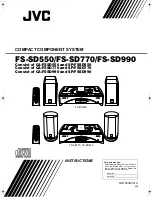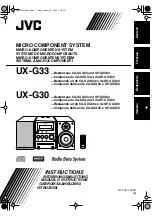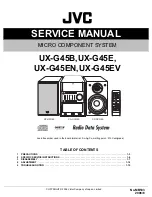
-6-
FM Antenna Connections
Adequate FM reception and subsequent sound quality is largely dependent upon your choice and location
of the antenna. There are several options to consider when selecting an antenna and connecting it to your
TDQ-150
Dipole Antenna
A standard FM “folded dipole” wire antenna is included with your TDQ-150. This antenna is adequate
for most urban and suburban locations and is very easy to install. Simply connect its spade connectors
to the screws marked 300
Ω
on the supplied small balun 300
Ω
to 75
Ω
adapter and push the adapter
carefully on to the round
“F” 75
Ω
coaxial antenna connector.
You should be prepared to adjust the position of the dipole antenna to optimize reception. Clear reception
of certain stations may require a different antenna orientation.
Outdoor Antenna
For best reception and maximum noise rejection, we recommend the use of a high-quality outdoor FM
antenna. Although this requires a little extra effort, the additional stations you can receive and the superior
sound quality will be well worthwhile. For best noise rejection, use 75
Ω
cable with an “F” connector and
connect it directly to the 75
Ω
coaxial antenna connector on your TDQ-150. If you use 300
Ω
twin lead
cable, use the balun adapter as described above.
Cable Transmission
Many cable companies transmit FM stations and cable TV audio signals along with the cable TV
channels. With some cable operators, the quality of the FM radio signal can be very good, depending on
the quality of their equipment. Check with your local cable company about the availability of FM stations
and possible additional charges for this service. Connection to your TDQ-150 is the same as connecting
a second television: Connect a signal splitter to the incoming cable connection and use a 75
Ω
F -type
connector to connect your television to one output of the splitter and the tuner to the other output.
Powered Antennas
A small powered indoor antenna is sometimes useful when it's impractical to install an outdoor antenna
or where FM transmission is not available via cable or a community TV/FM antenna. However, powered
antennas sometimes add noise and distortion to the RF signal. In most cases, you can receive signals better
with the supplied dipole antenna.
AM Antenna Connections
A molded plastic loop antenna is supplied with your TDQ-150. To install the antenna, attach the self-
adhesive receptacle to a convenient position on the TDQ-150 rear panel and connect the two wires to the
antenna terminals labeled AM and GND. Swivel the antenna away from the rear panel for better AM
reception. Never try to use the AM antenna to lift your TDQ-150, it will not support the weight of the
chassis.





























